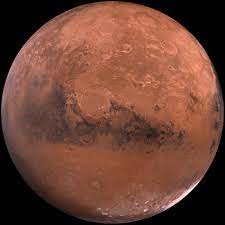Mysteries of the Red Planet

The red planet, Mars.
There may be life on Mars. No, not little green men or ancient civilizations that are plotting to invade Earth à la H.G. Wells, but microbes that live deep below the iconic red surface. While skeptics may scoff at the idea that a freezing planet without an atmosphere could possibly harbor life, recent discoveries point to a possibility that we must continue to explore.
Mars is a planet hostile to life, much more so than Earth, but it wasn’t always this way. Four billion years ago, around the time that life began to emerge on Earth, the two planets were very similar. Life on Earth most likely started in the primordial soup of hydrothermal vents, and since it has been proven that Mars also had hydrothermal vents in the past, life may have similarly emerged on Mars. Billions of years ago, early life could have thrived in the lakes that were so abundant on the surface and the thick Martian atmosphere filled with beneficial greenhouse gases.
Mars today is a different environment altogether. There is no liquid water on the surface, very little oxygen, an average daily temperature that ranges from -126°C to -60°C, and a surface that is constantly bombarded by harmful UV rays due to a combination of a lack of a magnetic field and a thin atmosphere. Though it may seem that Mars is inhabitable, there is a part of Mars that most people have not considered as a location for potential Martian life: the subsurface. Microbes could have evolved to live underground, where they would be shielded from radiation and where the geothermal heat would counteract the cold, harsh temperatures on the surface. Most excitingly, scientists have discovered that there are subsurface lakes full of liquid saltwater, which is notable because all known life forms need water to survive.
The recent discovery of microbial life two miles below the surface of the Witwatersrand Basin in South Africa provides a basis for the theory that Martian life could have adapted to live below the surface without sunlight. Instead of photosynthesis, these microbes undergo chemosynthesis, which means they derive energy from oxidizing inorganic compounds (e.g. hydrogen gas) to create energy. The surface of Mars is already oxidized, which is why it is red, but the subsurface would give these chemolithotrophs enough energy to survive.
This scenario could be written off as an intriguing, if unlikely, thought experiment. Sure, there may be life living below the Martian surface, but what proof is there? Ironically, a rover sent to Mars to determine whether the planet may once have harbored life has found the most convincing evidence we have thus far for extant Martian life. Mars Science Lab’s Curiosity rover has been exploring Gale Crater since 2012, and one of its objectives is to measure the planet’s atmospheric composition and surface conditions. It has found that the amount of methane in Mars’ atmosphere typically stays pretty steady around 1-2 parts per billion by volume (ppbv), but does regularly vary a little (there is a cyclical variation in the level of background methane) and in 2012, 2014, 2018, and 2019, the rover detected large transient plumes of methane, which implies that some source on Mars is releasing the gas. The concentration of methane in the atmosphere during the most recent plume detection in 2019 rose to 21ppbv, which is a drastic increase from background levels. It quickly fell back down to its normal measurements, but the mere presence of a variation of methane is an ongoing mystery because on Earth, the only known producers of methane are geological processes and biological metabolism. As Mars is not a geologically active planet, it is possible that this methane is a byproduct of life.
We may not yet have the tools to definitively detect life on Mars, but that is no reason to rule it out as a distinct possibility, perhaps even a probability. With the Perseverance rover’s landing on Mars earlier this year, we may be able to unravel the mysteries of the Red Planet soon.
Further Reading:
https://www.nature.com/articles/ncomms15978
https://www.nature.com/articles/nrmicro1991
https://www.nasa.gov/feature/jpl/curiosity-detects-unusually-high-methane-levels/












